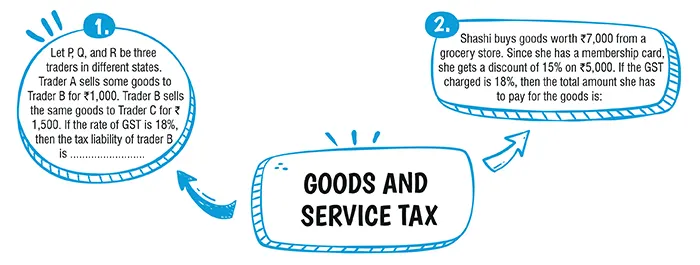Table of Contents

Ans. (c) ₹ 1,296
Explanation:
C.P. of an item =₹ 900
Marked price of an item
= ₹900 + 60% of ₹ 900
= ₹ 1,440
Discounted price of an item
=₹1,440−10% of ₹ 1,440
=₹1,296
⇒ Discounted price of 10 such items
= ₹ 12,960
∵Rate of GST = 10 %
∴CGST = SGST =5 % of ₹ 12,960
=₹648
So,
GST = CGST + SGST
=₹648+₹648
=₹1,296.
Ans. (d) ₹ 7,375
Explanation:
Total discounted price
= ₹ [2,000 + (5,000 - 15% of 5,000)]
= ₹ [2,000 + 4,250]
= ₹ 6,250
∵ GST rate = 18%
∴ CGST =SGST = 9% of ₹ 6,250
= ₹ 562.50
∴ Total amount Shashi has to pay
= ₹ 6,250 +₹ 562.50 + ₹ 562.50
= ₹ 7,375.
Explanation:
Sol. Given, wholesaler’s C.P. of a T.V.= ₹ 25,000
(i) Marked price of a T.V.
= ₹ 25,000 + 20% of ₹ 25,000
= ₹ 25,000 + ₹ 5,000
= ₹ 30,000. Ans.
(ii) Discount = 10% of ₹ 30,000
= 30,000 ×\frac{10}{100}×₹30,000 \\
Discount price
= ₹ 30,000 – ₹ 3,000
= ₹ 27,000
Tax for the wholesaler
= 8% of 27,000
= ₹ 2160
Retailer’s C.P. (Inclusive of all taxes)
= ₹ 27,000 + ₹ 2160
= ₹ 29,160. Ans.
(iii) Amount of GST to be paid by the wholesaler
= Tax on the value added by the wholesaler
= 8% of ₹ ( 27,000 – 25,000 )
=\frac{8}{100}×2000 \\
= ₹ 160. Ans
Explanation:
According to the question,GST on ticket of ₹ 90 = 18% of 90
=\frac{18}{100}×90
= ₹ 16.20
GST on ticket of ₹ 140 = 28% of 140
=\frac{28}{100}×140
= ₹ 39.20
Difference between both GST = 39.20 - 16.20
= ₹ 23.00
| S. No. | Item | Price | Rate of GST | Discount |
|---|---|---|---|---|
| 1 | Hair oil | ₹ 1200 | 18% | ₹ 100 |
| 2 | Cashew nuts | ₹ 600 | 12% |
Explanation:
Selling price of Hair oil = ₹ 1200 – ₹ 100 = ₹ 1100
GST @ 18% = ₹1100 × \frac{18}{100}=₹198
Selling price of cashew nuts = ₹ 600
GST @ 12% = ₹600 × \frac{12}{100} = ₹72
(a) Total GST paid= ₹ 198 + ₹ 72 = ₹ 270
(b) Total Bill including GST
= (S.P. + GST of Hair oil) + (SP + GST of cashew nuts)
= ₹ (1100 + 198) + ₹ (600 + 72)
= ₹ 1298 + ₹ 672 = ₹ 1970
Download Mind Map of this chapter
Download NowWant to Practice Mock Tests of this chapter
Practice NowDownload Important Questions of this chapter
Download Now| Chapter No. | Chapter Name |
|---|---|
| Chapter 1 | Goods and Service Tax (GST) |
| Chapter 2 | Banking |
| Chapter 3 | Shares and Dividends |
| Chapter 4 | Linear inequations |
| Chapter 5 | Quadratic Equations in one variable |
| Chapter 6 | Ratio and proportion |
| Chapter 7 | Factorization |
| Chapter 8 | Matrices |
| Chapter 9 | Arithmetic Progression |
| Chapter 10 | Geometric Progression |
| Chapter 11 | Coordinate Geometry |
| Chapter 12 | Reflection |
| Chapter 13 | Similarity |
| Chapter 14 | Loci |
| Chapter 15 | Circles |
| Chapter 16 | Constructions |
| Chapter 17 | Mensuration |
| Chapter 18 | Trigonometry |
| Chapter 19 | Statistics |
| Chapter 20 | Probability |
| Chapter Wise Important Questions for ICSE Board Class 10 Mathematics |
|---|
| Goods and Service Tax (GST) |
| Banking |
| Shares and Dividends |
| Linear inequations |
| Quadratic Equations in one variable |
| Ratio and proportion |
| Factorization |
| Matrices |
| Arithmetic Progression |
| Geometric Progression |
| Coordinate Geometry |
| Reflection |
| Similarity |
| Loci |
| Circles |
| Constructions |
| Mensuration |
| Trigonometry |
| Statistics |
| Probability |
CBSE Important Questions Class 10
ICSE Important Questions Class 10
CBSE Important Questions Class 10
ICSE Important Questions Class 10